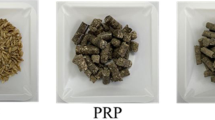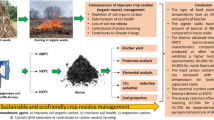Abstract
Manure storages, and in particular those storing digested manure, are a source of ammonia (NH3) emissions. Installing floating manure covers provide resistance to gas transfer from manure storage surface to air and reduces NH3 emissions; however, performance can be limited to durability. Biochar and steam-treated wood have strong potential as manure storage covers as they are capable of repelling water, resistant to microbial degradation, and could be applied to crop acreage. An additional benefit of biochars as a cover is their capability of NH3 sorption trapping TAN (total ammoniacal N) before it is volatilized resulting in further abatement. Installation of permeable manure storage covers is difficult and adding covers with agitators could facilitate implementation. This study measured NH3 emissions from laboratory scale storages of digested manure with raw wood (white birch, Betula papyrifera), steam-treated wood, wood biochar, and corncob biochar covers. Additional treatments included mixing biomass treatments into manure storages to measure the reduction potential of incorporated biomass. All treatments reduced emissions of NH3 from the control by 40 to 96%. The highest NH3 emissions reductions of 96% were achieved with the wood biochar cover. The primary mechanism for treatment was resistance to gas transfer provided by the physical barrier of covers as NH3 sorption did not correspond to reductions. Covering digested manure storages with any of the treatments can reduce NH3 emissions; biochar covers are a more effective barrier to NH3 emissions and are recommended to minimize NH3 manure storage losses.


Similar content being viewed by others
Abbreviations
- AD:
-
Anaerobic digestion
- BET:
-
Brunauer-Emmett-Teller method
- CEC:
-
Cation-exchange capacity
- CH4:
-
Methane
- CO2:
-
Carbon dioxide
- Cob BC C:
-
Cob biochar cover
- Cob BC I:
-
Incorporated cob biochar
- N2O:
-
Nitrous oxide
- NH3 :
-
Ammonia
- NH4 :
-
Ammonium
- Steamed C:
-
Steamed wood cover
- Steamed I:
-
Incorporated-steamed wood
- TAN:
-
Total ammoniacal nitrogen
- TKN:
-
Total Kjeldahl nitrogen
- Wood BC I:
-
Incorporated wood biochar
- Wood C:
-
Wood cover
- Wood I:
-
Incorporated wood cover
- Wood BC C:
-
Wood biochar cover
References
Adjei, T. (2007). Characterization of a novel biodegradable material to reduce emission of ammonia [Thesis]. Virginia Polytechnic Institute and State University. http://hdl.handle.net/10919/30949. Accessed 27 Oct 2017.
Amon, B., Kryvoruchko, V., Amon, T., & Zechmeister-Boltenstern, S. (2006). Methane, nitrous oxide and ammonia emissions during storage and after application of dairy cattle slurry and influence of slurry treatment. Agriculture, Ecosystems & Environment, 112(2–3), 153–162. https://doi.org/10.1016/j.agee.2005.08.030.
ASTM International. (2013). ASTM E871-82 (2013), Standard test method for moisture analysis of particulate wood fuels. PA, U.S.A: West Conshohocken www.astm.org.
ASTM International. (2015). ASTM D3663-03 (2015), Standard test method for surface area of catalysts and catalyst carriers. PA, U.S.A: West Conshohocken www.astm.org.
ASTM International. (2016). ASTM D5373-16, Standard test methods for determination of carbon, hydrogen and nitrogen in analysis samples of coal and carbon in analysis samples of coal and coke. PA, U.S.A: West Conshohocken www.astm.org.
Berg, W., Brunsch, R., & Pazsiczki, I. (2006). Greenhouse gas emissions from covered slurry compared with uncovered during storage. Agriculture, Ecosystems and Environment, 112(2–3), 129–134. https://doi.org/10.1016/j.agee.2005.08.031.
Borchard, N., Prost, K., Kautz, T., Moeller, A., & Siemens, J. (2012). Sorption of copper (II) and sulphate to different biochars before and after composting with farmyard manure. European Journal of Soil Science, 63(3), 399–409. https://doi.org/10.1111/j.1365-2389.2012.01446.x.
Cheng, C. H., & Lehmann, J. (2009). Ageing of black carbon along a temperature gradient. Chemosphere, 75(8), 1021–1027. https://doi.org/10.1016/j.chemosphere.2009.01.045.
Christensen, M. L., Christensen, K. V, & Sommer, S. G. (2013). Solid-liquid separation of animal slurry. In S. G. Sommer, M. L. Christensen, T. Schmidt, & L. S. Jensen (Eds.), Animal manure recycling: treatment and management (First., pp. 105–130). Chichester: John Wiley & Sons, Ltd.
Clemens, J., Trimborn, M., Weiland, P., & Amon, B. (2006). Mitigation of greenhouse gas emissions by anaerobic digestion of cattle slurry. Agriculture, Ecosystems & Environment, 112(2–3), 171–177. https://doi.org/10.1016/j.agee.2005.08.016.
Crombie, K., Masek, O., Sohi, S. P., Brownsort, P., & Cross, A. (2013). The effect of pyrolysis conditions on biochar stability as determined by three methods. GCB Bioenergy, 5(2), 122–131. https://doi.org/10.1111/gcbb.12030.
Ding, Y., Liu, Y.-X., Wu, W.-X., Shi, D.-Z., Yang, M., & Zhong, Z.-K. (2010). Evaluation of biochar effects on nitrogen retention and leaching in multi-layered soil columns. Water, Air, & Soil Pollution, 213(1–4), 47–55. https://doi.org/10.1007/s11270-010-0366-4.
Gai, X., Wang, H., Liu, J., Zhai, L., Liu, S., Ren, T., & Liu, H. (2014). Effects of feedstock and pyrolysis temperature on biochar adsorption of ammonium and nitrate. PLoS One, 9(12), e113888. https://doi.org/10.1371/journal.pone.0113888.
Guarino, M., Fabbri, C., Brambilla, M., Valli, L., & Navarotto, P. (2006). Evaluation of simplified covering systems to reduce gaseous emissions from livestock manure storage. Transactions of the ASABE, 49(3), 737–748.
Hale, S. E., Alling, V., Martinsen, V., Mulder, J., Breedveld, G. D., & Cornelissen, G. (2013). The sorption and desorption of phosphate-P, ammonium-N and nitrate-N in cacao shell and corn cob biochars. Chemosphere, 91(11), 1612–1619. https://doi.org/10.1016/j.chemosphere.2012.12.057.
Holly, M. A., Larson, R. A., Powell, J. M., Ruark, M. D., & Aguirre-Villegas, H. (2017). Greenhouse gas and ammonia emissions from digested and separated dairy manure during storage and after land application. Agriculture, Ecosystems and Environment, 239, 410–419. https://doi.org/10.1016/j.agee.2017.02.007.
Hou, Y., Velthof, G. L., & Oenema, O. (2015). Mitigation of ammonia, nitrous oxide and methane emissions from manure management chains: A meta-analysis and integrated assessment. Global Change Biology, 21(3), 1293–1312. https://doi.org/10.1111/gcb.12767.
Ippolito, J. A., Spokas, K. A., Novak, J. M., Lentz, R. D., & Cantrell, K. B. (2015). Biochar elemental composition and factors influencing nutrient retention. In Biochar for environmental management: science, technology and implementation (pp. 139–165).
Lam, P. S., Sokhansanj, S., Bi, X., Lim, C. J., & Melin, S. (2011). Energy input and quality of pellets made from steam-exploded douglas fir (Pseudotsuga menziesii). Energy and Fuels, 25(4), 1521–1528. https://doi.org/10.1021/ef101683s.
Lin, Y., Munroe, P., Joseph, S., Henderson, R., & Ziolkowski, A. (2012). Water extractable organic carbon in untreated and chemical treated biochars. Chemosphere, 87(2), 151–157. https://doi.org/10.1016/j.chemosphere.2011.12.007.
Malińska, K., Zabochnicka-Świątek, M., & Dach, J. (2014). Effects of biochar amendment on ammonia emission during composting of sewage sludge. Ecological Engineering, 71, 474–478. https://doi.org/10.1016/j.ecoleng.2014.07.012.
Mohan, D., Kumar, S., & Srivastava, A. (2014). Fluoride removal from ground water using magnetic and nonmagnetic corn stover biochars. Ecological Engineering, 73, 798–808. https://doi.org/10.1016/j.ecoleng.2014.08.017.
Nelissen, V., Rütting, T., Huygens, D., Staelens, J., Ruysschaert, G., & Boeckx, P. (2012). Maize biochars accelerate short-term soil nitrogen dynamics in a loamy sand soil. Soil Biology and Biochemistry, 55, 20–27. https://doi.org/10.1016/j.soilbio.2012.05.019.
Nicolai, R., Pohl, S., & Schmidt, D. (2004). Covers for manure storage units. South Dakota Cooperative Extension Service Publication. pubstorage.sdstate.edu/AgBio_Publications/articles/FS925-D.pdf. Accessed 27 Oct 2017.
Paulot, F., Jacob, D. J., Pinder, R. W., Bash, J. O., Travis, K., & Henze, D. K. (2014). Ammonia emissions in the United States, European Union, and China derived by high-resolution inversion of ammonium wet deposition data: Interpretation with a new agricultural emissions inventory (MASAGE-NH3). Journal of Geophysical Research: Atmospheres, 119(7), 4343–4364. https://doi.org/10.1002/2013JD021130.
Peters, J., Combs, S., Hoskins, B., Jarman, J., Kovar, J., Watson, M., et al. (2003). Recommended Methods of Manure Analysis (A3769). http://learningstore.uwex.edu/assets/pdfs/A3769.pdf. Accessed 27 Oct 2017.
Rajkovich, S., Enders, A., Hanley, K., Hyland, C., & Zimmerman, A. R. (2012). Corn growth and nitrogen nutrition after additions of biochars with varying properties to a temperate soil. Biology and Fertility of Soils, 48, 271–284. https://doi.org/10.1007/s00374-011-0624-7.
Sika, M. P., & Hardie, A. G. (2014). Effect of pine wood biochar on ammonium nitrate leaching and availability in a South African sandy soil. European Journal of Soil Science, 65(1), 113–119. https://doi.org/10.1111/ejss.12082.
Smith, K., Cumby, T., Lapworth, J., Misselbrook, T., & Williams, A. (2007). Natural crusting of slurry storage as an abatement measure for ammonia emissions on dairy farms. Biosystems Engineering, 97(4), 464–471. https://doi.org/10.1016/j.biosystemseng.2007.03.037.
Sommer, S. G., Christensen, B. T., Nielsen, N. E., & Schjφrring, J. K. (1993). Ammonia volatilization during storage of cattle and pig slurry: effect of surface cover. The Journal of Agricultural Science, 121(1), 63. https://doi.org/10.1017/S0021859600076802.
Spokas, K. A., Cantrell, K. B., Novak, J. M., Archer, D. W., Ippolito, J. A., Collins, H. P., et al. (2012a). Biochar: a synthesis of its agronomic impact beyond carbon sequestration. Journal of Environment Quality, 41(4), 973. https://doi.org/10.2134/jeq2011.0069.
Spokas, K. A., Novak, J. M., & Venterea, R. T. (2012b). Biochar’s role as an alternative N-fertilizer: ammonia capture. Plant and Soil, 350(1–2), 35–42. https://doi.org/10.1007/s11104-011-0930-8.
Taghizadeh-Toosi, A., Clough, T. J., Sherlock, R. R., & Condron, L. M. (2012a). A wood based low-temperature biochar captures NH3-N generated from ruminant urine-N, retaining its bioavailability. Plant and Soil, 353(1–2), 73–84. https://doi.org/10.1007/s11104-011-1010-9.
Taghizadeh-Toosi, A., Clough, T. J., Sherlock, R. R., & Condron, L. M. (2012b). Biochar adsorbed ammonia is bioavailable. Plant and Soil, 350(1–2), 57–69. https://doi.org/10.1007/s11104-011-0870-3.
Theuretzbacher, F., Lizasoain, J., Lefever, C., Saylor, M. K., Enguidanos, R., Weran, N., et al. (2015). Steam explosion pretreatment of wheat straw to improve methane yields: investigation of the degradation kinetics of structural compounds during anaerobic digestion. Bioresource Technology, 179, 299–305. https://doi.org/10.1016/j.biortech.2014.12.008.
Uludag-Demirer, S., Demirer, G. N., Frear, C., & Chen, S. (2008). Anaerobic digestion of dairy manure with enhanced ammonia removal. Journal of Environmental Management, 86(1), 193–200. https://doi.org/10.1016/j.jenvman.2006.12.002.
USEPA. (1983). Methods of chemical analysis of water and waste, Section 9.3. Cincinnati: EPA/600/4-79/020.
VanderZaag, A. C., Gordon, R. J., Glass, V. M., & Jamieson, R. C. (2008). Floating covers to reduce gas emissions from liquid manure storages: a review. American Society of Agricultural and Biological Engineers, 24(5), 657–672.
VanderZaag, A. C., Gordon, R. J., Jamieson, R. C., Burton, D. L., & Stratton, G. W. (2009). Gas emissions from straw covered liquid dairy manure during summer storage and autumn agitation. Transactions of the ASABE, 52(2), 599–608.
Wang, B., Lehmann, J., Hanley, K., Hestrin, R., & Enders, A. (2015). Adsorption and desorption of ammonium by maple wood biochar as a function of oxidation and pH. Chemosphere, 138, 120–126. https://doi.org/10.1016/j.chemosphere.2015.05.062.
Webb, J., Menzi, H., Pain, B. F., Misselbrook, T. H., Dammgen, U., Hendriks, H., & Dohler, H. (2005). Managing ammonia emissions from livestock production in Europe. Environmental Pollution, 135(3 SPEC. ISS), 399–406. https://doi.org/10.1016/j.envpol.2004.11.013.
WHO. (2005). Ambient (outdoor) air quality and health. Fact sheets. World Health Organization. http://www.who.int/mediacentre/factsheets/fs313/en/. Accessed 14 Aug 2016.
Zhao, X., Wang, S., & Xing, G. (2014). Nitrification, acidification, and nitrogen leaching from subtropical cropland soils as affected by rice straw-based biochar: Laboratory incubation and column leaching studies. Journal of Soils and Sediments, 14(3), 471–482. https://doi.org/10.1007/s11368-013-0803-2.
Acknowledgements
This material is based upon work that is supported by the National Institute of Food and Agriculture, U.S. Department of Agriculture, under award number 2015-67019-23573. We would like to thank Dr. Troy Runge for his help with the acquisition of materials and help with biomass processing.
Author information
Authors and Affiliations
Corresponding author
Ethics declarations
Ethic Statement
Any opinions, findings, conclusions, or recommendations expressed in this publication are those of the author(s) ansd do not necessarily reflect the view of the U.S. Department of Agriculture.
Rights and permissions
About this article
Cite this article
Holly, M.A., Larson, R.A. Thermochemical Conversion of Biomass Storage Covers to Reduce Ammonia Emissions from Dairy Manure. Water Air Soil Pollut 228, 434 (2017). https://doi.org/10.1007/s11270-017-3588-x
Received:
Accepted:
Published:
DOI: https://doi.org/10.1007/s11270-017-3588-x




